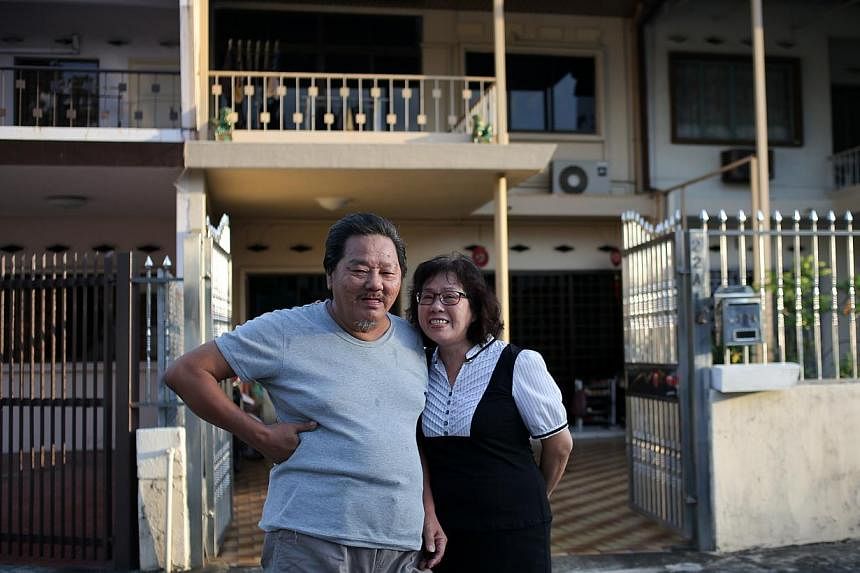Growing up, Ms Thian Hwee Keong used to sit by the Geylang River and watch as her father roasted coffee beans in a huge bronze drum.
An itinerant hawker, her late father Thian Oayin Mui was known around the Kallang area in the 1960s for his coffee beans, which he painstakingly selected and processed.
This meant that large gunny sacks of green coffee beans were a constant fixture in the living room of the family's two-room rental flat in Dakota Crescent, she said.
"Once every fortnight, he would roll this heavy drum from our home to the river, which was about a five- minute walk away," recalled Ms Thian, who has three brothers.
"My brothers and I would pick up wooden planks for the fire, and I'd sit by the riverbank to watch him roast the coffee seeds. It was always a great fire."
When the green coffee beans turned brown, Mr Thian would stir them in margarine and sugar, before packing them in biscuit tins and sending them to a factory to be ground into powder.
The scent of roasted coffee meant her father was known in their neighbourhood as "kopi-chek" (coffee uncle), laughed Ms Thian, 61, who works in patient administration at the Singapore General Hospital.
While the drinks business had its share of loyal customers, Ms Thian remembers how poor her family was.
"We had one table and one chair when we first moved in," recalled Ms Thian. "My mother said if we saved money, we could buy one chair every month. So they bought the chairs one by one. That's how poor we were."
Her parents also had to contend with the authorities, who did not look kindly on street hawkers because of hygiene and public order problems in the 1960s.
It was a problem former Prime Minister Lee Kuan Yew recalled in his memoirs, From Third World To First.
"Thousands would sell cooked food on the pavements and streets in total disregard of traffic, health or other considerations," said Mr Lee.
"The resulting litter and dirt, the stench of rotting food and the clutter and obstructions turned many parts of the city into slums."
To clamp down on such hawking, officers would conduct spot checks and street hawkers would be fined, said Ms Thian.
"My father had kakis (friends) who kept an eye out, and when we heard the words 'officers coming, faster close', we would pack up in a hurry and leave," she said. "But sometimes, he would be caught and fined."
After independence in 1965, Mr Lee's Government made a clean and modern Singapore a priority, and relocated hawkers like Mr Thian away from the main streets.
He set up his first permanent stall near Kallang Road, in a row of zinc-roofed hawker stalls built by the Government. Rent was heavily subsidised and, for the first time, he had access to piped water, gas and electricity.
This meant he could run his business later into the night, and expand his fare to include toast, boiled eggs and a selection of cold drinks.
"He became a legal tenant, and no longer had to hide from the inspectors. It was from here that my father started to prosper," said Ms Thian.
Mr Thian was among 18,000 street hawkers licensed by the Government in an islandwide hawker registration exercise in 1968 and 1969.
They had to stick to rules such as not smoking while preparing food, and not throwing water or rubbish into drains. For Mr Thian, it was the end of his coffee roasting days, as the authorities deemed his bean roasting pollutive.
But while business boomed for Mr Thian, whose stall was located near a bus stop used by Malaysian tourists, many of his peers were reluctant to move into permanent spaces.
"Accustomed to doing business on the road rent-free and easily accessible to customers, they resisted moving to centres where they would have to pay rent and water and electricity charges," Mr Lee wrote in his memoirs.
Undeterred, the Government embarked on an aggressive programme in 1971 to build permanent facilities to house hawkers.
It also formed the Hawkers' Department Special Squad, conducting multiple raids daily to get rid of all illegal hawking. Within six months, the illegal hawking situation was under control.
In 1973, Mr Thian became one of the first hawkers to move into the newly built Old Airport Road Food Centre. The Government would build hawker centres at a breakneck pace, opening No. 103 in 1986.
Mr Thian continued to sell coffee and toast at the same stall for the next 15 years.
On the back of coffee and toast, Ms Thian said, her father was eventually able to buy a whole coffee shop, as well their family's first private apartment in Joo Chiat in the 1970s.
He sold it and moved with the family into a semi-detached house in Tembeling Street, where one of her brothers still lives today.
"Mr Lee Kuan Yew gave my parents a livelihood, an opportunity to make a decent living and to raise four children," she said. "No words can express my gratitude to Mr Lee for taking us from poverty to prosperity. I will forever remember him, and may he rest in peace."


